Oil and Gas Industry
[vc_row height=”small” color_scheme=”alternate” us_bg_image_source=”featured” us_bg_parallax=”vertical” us_bg_overlay_color=”rgba(51,51,51,0.65)” columns=”2-1″ css=”%7B%22default%22%3A%7B%22text-align%22%3A%22center%22%7D%7D”][vc_column width=”2/3″][us_post_title align=”center” tag=”h1″][us_separator size=”large”][us_separator size=”large”][us_separator size=”large”][us_separator size=”large”][vc_column_text]
The oil and gas industry generates significant amounts of wastewater from upstream and downstream activities which must be managed. Produced water and other wastewater sources need to be cleaned and treated before release into the environment as they can be highly polluted. ClearFox® has developed a range of modular solutions to treat produced water.
[/vc_column_text][/vc_column][vc_column width=”1/3″][vc_column_text]
GET IN TOUCH NOW
[/vc_column_text][us_cform items=”%5B%7B%22type%22%3A%22text%22%2C%22inputmode%22%3A%22text%22%2C%22date_format%22%3A%22d%20MM%20yy%22%2C%22label%22%3A%22%22%2C%22description%22%3A%22%22%2C%22placeholder%22%3A%22Name%22%2C%22values%22%3A%22%22%2C%22value%22%3A%22%22%2C%22required%22%3A0%2C%22is_used_as_from_email%22%3A0%2C%22is_used_as_from_name%22%3A0%2C%22move_label%22%3A0%2C%22accept%22%3A%22%22%2C%22file_max_size%22%3A%2210MB%22%2C%22icon%22%3A%22%22%2C%22cols%22%3A%221%22%7D%2C%7B%22type%22%3A%22email%22%2C%22inputmode%22%3A%22text%22%2C%22date_format%22%3A%22d%20MM%20yy%22%2C%22label%22%3A%22%22%2C%22description%22%3A%22%22%2C%22placeholder%22%3A%22Email%22%2C%22values%22%3A%22%22%2C%22value%22%3A%22%22%2C%22required%22%3A1%2C%22is_used_as_from_email%22%3A0%2C%22is_used_as_from_name%22%3A0%2C%22move_label%22%3A0%2C%22accept%22%3A%22%22%2C%22file_max_size%22%3A%2210MB%22%2C%22icon%22%3A%22%22%2C%22cols%22%3A%221%22%7D%2C%7B%22type%22%3A%22text%22%2C%22inputmode%22%3A%22text%22%2C%22date_format%22%3A%22d%20MM%20yy%22%2C%22label%22%3A%22%22%2C%22description%22%3A%22%22%2C%22placeholder%22%3A%22Phone%22%2C%22values%22%3A%22%22%2C%22value%22%3A%22%22%2C%22required%22%3A0%2C%22is_used_as_from_email%22%3A0%2C%22is_used_as_from_name%22%3A0%2C%22move_label%22%3A0%2C%22accept%22%3A%22%22%2C%22file_max_size%22%3A%2210MB%22%2C%22icon%22%3A%22%22%2C%22cols%22%3A%221%22%7D%2C%7B%22type%22%3A%22text%22%2C%22inputmode%22%3A%22text%22%2C%22date_format%22%3A%22d%20MM%20yy%22%2C%22label%22%3A%22%22%2C%22description%22%3A%22%22%2C%22placeholder%22%3A%22Text%22%2C%22values%22%3A%22%22%2C%22value%22%3A%22%22%2C%22required%22%3A0%2C%22is_used_as_from_email%22%3A0%2C%22is_used_as_from_name%22%3A0%2C%22move_label%22%3A0%2C%22accept%22%3A%22%22%2C%22file_max_size%22%3A%2210MB%22%2C%22icon%22%3A%22%22%2C%22cols%22%3A%221%22%7D%2C%7B%22type%22%3A%22agreement%22%2C%22inputmode%22%3A%22text%22%2C%22date_format%22%3A%22d%20MM%20yy%22%2C%22label%22%3A%22%22%2C%22description%22%3A%22%22%2C%22placeholder%22%3A%22%22%2C%22values%22%3A%22%22%2C%22value%22%3A%22You%20agree%20that%20your%20data%20may%20be%20used%20to%20process%20your%20request.%20Further%20information%20and%20revocation%20instructions%20can%20be%20found%20in%20the%20%3Ca%20href%3D%5C%22https%3A%2F%2Fstage.clearfox.com%2Fprivacy-policy%2F%5C%22%20target%3D%5C%22_blank%5C%22%20rel%3D%5C%22noopener%5C%22%3Eprivacy%20policy%3C%2Fa%3E.%20%22%2C%22required%22%3A0%2C%22is_used_as_from_email%22%3A0%2C%22is_used_as_from_name%22%3A0%2C%22move_label%22%3A0%2C%22accept%22%3A%22%22%2C%22file_max_size%22%3A%2210MB%22%2C%22icon%22%3A%22%22%2C%22cols%22%3A%221%22%7D%2C%7B%22type%22%3A%22checkboxes%22%2C%22inputmode%22%3A%22text%22%2C%22date_format%22%3A%22d%20MM%20yy%22%2C%22label%22%3A%22%22%2C%22description%22%3A%22%22%2C%22placeholder%22%3A%22%22%2C%22values%22%3A%22You%20consent%20to%20receive%20our%20newsletter%22%2C%22value%22%3A%22%22%2C%22required%22%3A0%2C%22is_used_as_from_email%22%3A0%2C%22is_used_as_from_name%22%3A0%2C%22move_label%22%3A0%2C%22accept%22%3A%22%22%2C%22file_max_size%22%3A%2210MB%22%2C%22icon%22%3A%22%22%2C%22cols%22%3A%221%22%7D%5D” button_text=”Send” receiver_email=”info@stage.clearfox.com”][/vc_column][/vc_row][vc_row height=”medium” columns=”1-3″][vc_column css=”%7B%22default%22%3A%7B%22animation-name%22%3A%22afl%22%7D%7D” width=”1/4″][vc_column_text]
Sector
[/vc_column_text][/vc_column][vc_column css=”%7B%22default%22%3A%7B%22animation-name%22%3A%22afr%22%7D%7D” width=”3/4″][vc_column_text]
The oil and gas sector is listed among the top ten largest water consumers and causes significant water pollution. The oil and gas industry is faced with higher standards for environmental protection and due to the current global market, lower prices. The environmental situation is exacerbated by a lack of water at most drilling sites. At many locations, the wastewater is not adequately treated to comply with local legislation. Wastewater treatment of produced water in oil fields is now considered to be a priority.
The wastewater on oil and gas well fields can be contaminated in different ways. We use our approved-and-tested module system and select the technology used with an evaluation procedure that is always tailored to the specific requirement.
With our modular system, we have experience worldwide in cleaning a wide variety of wastewater types. We are members of the leading professional associations in Germany:
- VDE-Association German Technologies Electrical, electronical and information
- VDI-Association German Engineers
- ATV/DWA- German Wastewater associational
[/vc_column_text][/vc_column][/vc_row][vc_row height=”medium” columns=”1-3″][vc_column css=”%7B%22default%22%3A%7B%22animation-name%22%3A%22afl%22%7D%7D” width=”1/4″][vc_column_text]
Challenges
[/vc_column_text][/vc_column][vc_column css=”%7B%22default%22%3A%7B%22animation-name%22%3A%22afr%22%7D%7D” width=”3/4″][vc_column_text]
The wastewater from the oil and gas sector is highly variable in its volume and pollution load. This depends on many factors. So in each case a specific solution must be designed. By utilising our modular process technologies, we can adapt modules to handle any flowrate, any pollution loading and any effluent requirement.
Characteristics of produced wastewater are described below;
The usual sewage parameters for assessing the water quality or the efficiency of the treatment technology are as follows: (different analyses from Siberia, USA, South America and Mediterranean Sea)
- pH 4-7
- Oil content can be up to 1 g/l but is mostly removed from the produced water (as it is the valuable substance)
- Salt concentration (salinity): The salinity is a typical characteristic of the produced wastewater. It can contain over 180,000 mg/l. This can usually be seen from the TDS, which essentially consists of sodium chloride. The chloride content is also an important indicator. Much produced wastewater is considered hypersaline, i.e. oversaturated with salt.
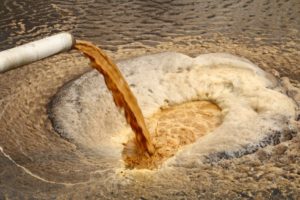
- Totally dissolved solids (TDS) up to 300,000 mg/l, mainly caused from NaCl
- Totally suspended solids (TSS) between 50 and 1,000 mg/l
- Temperature 15 to 35 degree Celsius regionally dependent
- Hydrocarbons (aliphatic and aromatic)
- Volatile, aromatic hydrocarbons BTEX (sum of Benzene, Toluene, Ethylbenzene and Xylene) and polycyclic, aromatic hydrocarbons PAH (PAH and alkyl phenols are not very good soluble in the wastewater.)
- Organic acids such as Benzoic acids
- Dispersed hydrocarbons, naphtha residues
- Sum parameter for oxygen demand (chemical oxygen demand COD, biological oxygen demand BOD, usually determined in 5 days).
The ratio of these two typical sum parameters gives an indication of the degradability of wastewater. BOD values vary from 500 to 3,000 mg/l
COD values vary from 2,000 to 20,000 mg/l - Nitrogen, Phosphorus (only seen as traces in relation to carbon, but may contain an excess of nitrogen, which must be removed for some direct discharges)
- Sulfides, depending on injection water
- Heavy metals (Boron, Cadmium, Copper, Mercury, Iron and much more)
- Radioactive materials (NORM, technically enhanced), as already discussed before
- Uranium, thorium, radium with his decay products as well as radon Lead 210, potassium 40, polonium (Partially gaseous, especially concentrated in the sludge and deposits, loads of up to 15,000 Becquerel / gram, average waste load 100 Bq/g)
[/vc_column_text][/vc_column][/vc_row][vc_row columns=”1-3″][vc_column css=”%7B%22default%22%3A%7B%22animation-name%22%3A%22afl%22%7D%7D” width=”1/4″][vc_column_text]
Solution
[/vc_column_text][/vc_column][vc_column css=”%7B%22default%22%3A%7B%22animation-name%22%3A%22afr%22%7D%7D” width=”3/4″][vc_column_text]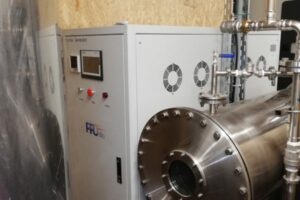 ClearFox® Ozone Generator
ClearFox® Ozone Generator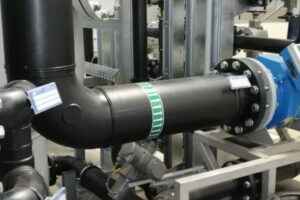 ClearFox® AEO (Advanced Electro Oxidation)
ClearFox® AEO (Advanced Electro Oxidation)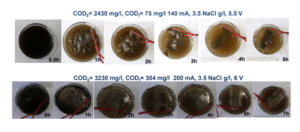 AEO test
AEO test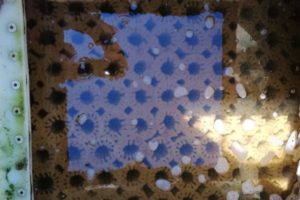 ClearFox® FBR with halophine bacteria
ClearFox® FBR with halophine bacteria ClearFox® activated carbon after fuzzy filtration and DAP[/vc_column_text][/vc_column][/vc_row][vc_row columns=”1-3″][vc_column css=”%7B%22default%22%3A%7B%22animation-name%22%3A%22afl%22%7D%7D” width=”1/4″][vc_column_text]
ClearFox® activated carbon after fuzzy filtration and DAP[/vc_column_text][/vc_column][/vc_row][vc_row columns=”1-3″][vc_column css=”%7B%22default%22%3A%7B%22animation-name%22%3A%22afl%22%7D%7D” width=”1/4″][vc_column_text]
Technology
[/vc_column_text][/vc_column][vc_column css=”%7B%22default%22%3A%7B%22animation-name%22%3A%22afr%22%7D%7D” width=”3/4″][vc_column_text]
Comparison of process technologies for produced water
| process | Capex | Opex | stability | secondary pollution | efficiency | Space required |
| Mechanical treatment | +++ | ++ | + | + | +++ | – |
| DAP | +++ | – | + | — | ++ | + |
| DAF | +++ | + | + | – | + | + |
| Chemical Precipitation | +++ | – | + | — | + | +++ |
| Oxidation general | – | – | + | +++ | ++ | |
| Ozone, Kat-wet | — | +++ | ++ | +++ | ++ | ++ |
| AEO | — | +++ | + | +++ | +++ | ++ |
| Biological treatment | – | +++ | + | +++ | + | — |
| Ultrafiltration/Nano | + | + | + | ++ | ++ | + |
| ROA (Osmosis) | — | — | + | + | +++ | + |
| Mikro/Sand Antracit Filters | +++ | +++ | +++ | +++ | + | + |
| Adsorption AC | + | — | ++ | – | ++ | — |
[/vc_column_text][/vc_column][/vc_row][vc_row height=”small” width=”1″][vc_column][vc_column_text]
Read More About ClearFox® Oil & Gas Projects
[/vc_column_text][us_grid post_type=”us_portfolio” taxonomy_us_portfolio_category=”oil-gas-drilling-sites,pet” orderby=”menu_order” items_quantity=”4″ items_layout=”18770″ type=”masonry” columns=”4″ items_gap=”” overriding_link=”post”][us_btn label=”More Industrial Projects” link=”url:https%3A%2F%2Fstage.clearfox.com%2Fprojects%2F%3Ffilter_us_portfolio_category%3Dindustrial” align=”center”][/vc_column][/vc_row][vc_row height=”large” color_scheme=”primary”][vc_column][us_cta title=”Speak to one of our team today” controls=”bottom” btn_label=”contact us now” btn_link=”url:https%3A%2F%2Fstage.clearfox.com%2Fcontact%2F”]We will find a special solution for you![/us_cta][/vc_column][/vc_row]